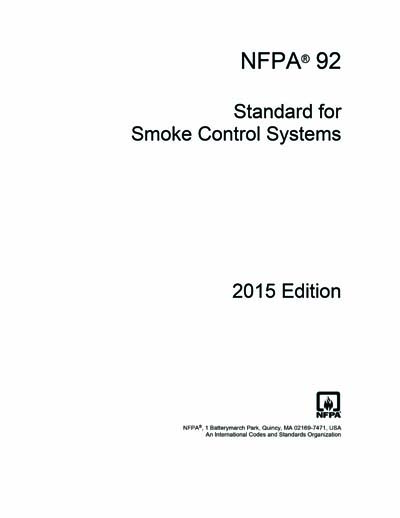Historical
NFPA 92-2015
NFPA 92 Standard for Smoke Control Systems, 2015 edition
1.1* Scope. This standard shall cover the design and installation of automatic sprinkler systems for protection against fire hazards in residential occupancies up to and including four stories in height in buildings not exceeding 60 ft (18 m) in height above grade plane. A.1.1 NFPA 13R is appropriate for use as an option to NFPA 13 only in those residential occupancies, as defined in this standard, up to and including four aboveground stories in height, and limited to buildings that are 60 ft (18 m) or less in height above grade plane, which is consistent with limits established by model building codes for buildings of Type V construction. The height of a building above grade plane is determined by model building codes, which base the height on the average height of the highest roof surface above grade plane. For further information on the building height story limits, see model building codes. It is the intent of this standard that if NFPA13R is appropriate for use, it be used throughout the entire building. It is recognized that an accessory or incidental occupancy to the operations of the residential occupancy might exist within that residential occupancy. Such accessory or incidental occupancy would be considered part of the predominant (residental) occupancy and subject to the provisions of the predominant (residental) occupancy by 6.1.14.2 of NFPA 101 and similar provisions in many local building and fire codes. Use of NFPA13R throughout the entire building in this case is allowed. Where buildings are greater than four stories in height, or where buildings are of mixed use where residential is not the predominant occupancy, residential portions of such buildings should be protected with residential or quick-response sprinklers in accordance with 8.4.5 of NFPA 13. Other portions of such buildings should be protected in accordance with NFPA 13. Where buildings of mixed use can be totally separated so that the residential portion is considered a separate building under the local code, NFPA13R can be used in the residential portion while NFPA13 is used in the rest of the building. Examples of accessory occupancies found in NFPA 13R installations can include parking garages/areas, community laundry rooms, clubhouses, exercise facilities, tenant storage, and so forth. The criteria in this standard are based on full-scale fire tests of rooms containing typical furnishings found in residential living rooms, kitchens, and bedrooms. The furnishings were arranged as typically found in dwelling units in a manner similar to that shown in Figure A.1.1(a), Figure A.1.1(b), and Figure A.1.1(c). Sixty full-scale fire tests were conducted in a two-story dwelling in Los Angeles, California, and 16 tests were conducted in a 14 ft (4.3 m) wide mobile home in Charlotte, North Carolina. Sprinkler systems designed and installed according to this standard are expected to prevent flashover within the compartment of origin where sprinklers are installed in the compartment. A sprinkler system designed and installed according to this standard cannot, however, be expected to completely control a fire involving fuel loads that are significantly higher than average for dwelling units [10 lb/ft2 (49 kg/m2)], configurations of fuels other than those with typical residential occupancies, or conditions where the interior finish has an unusually high flame spread index (greater than 225). To be effective, sprinkler systems installed in accordance with this standard need to open the sprinklers closest to the fire before the fire exceeds the ability of the sprinkler discharge to extinguish or control the fire. Conditions that allow the fire to grow beyond that point before sprinkler activation or that interfere with the quality of water distribution can produce conditions beyond the capabilities of the sprinkler system described in this standard. Unusually high ceilings or ceiling configurations that tend to divert the rising hot gases from sprinkler locations or change the sprinkler discharge pattern from its standard pattern can produce fire conditions that cannot be extinguished or controlled by the systems described in this standard. NFPA 13R references NFPA 13 in many aspects (hanging and bracing, design densities and spacing outside of dwelling unit, painting and finish of sprinklers, welding, etc.). If this standard does not specifically address a situation, NFPA 13 is a good resource that can be utilized by the installer and the authority having jurisdiction for a solution. It is not the intent of this standard to require compliance with NFPA 13 when NFPA 13R is silent on a subject. Only AHJ approval should be required. ****INSERT FIGURE HERE**** FIGURE A.1.1(a) Bedroom. ****INSERT FIGURE HERE**** FIGURE A.1.1(b) Manufactured Home Bedroom. ****INSERT FIGURE HERE**** FIGURE A.1.1(c) Living Room. 1.1.1 This standard shall be based on the concept that the sprinkler system is designed to protect against a fire originating from a single ignition location. 1.1.2 This standard shall not provide requirements for the design or installation of water mist fire protection systems, which are not considered fire sprinkler systems and are addressed by NFPA 750.
Content Provider
National Fire Protection Association [nfpa]






